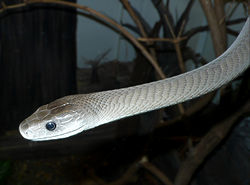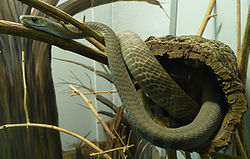Black mamba
| Black mamba | ||||||||||||||||
|---|---|---|---|---|---|---|---|---|---|---|---|---|---|---|---|---|
 |
||||||||||||||||
| Scientific classification | ||||||||||||||||
|
||||||||||||||||
| Binomial name | ||||||||||||||||
| Dendroaspis polylepis |
The Black Mamba (Dendroaspis polylepis), is an elapid snake and is one of Africa's most dangerous and feared snakes. It has a wide range of known locations throughout Africa. The black mamba is found in Somalia, Ethiopia, Kenya, Botswana, Uganda, Zambia, Zimbabwe, Angola, Namibia, Malawi, Mozambique, South Africa and the Congo. They inhabit a wide variety of areas that include open savannahs, open woodlands, and rocky outcrops.[1] It is also known for being very aggressive when disturbed or confronted and will not hesitate to strike with deadly precision.
The black mamba is the largest venomous snake in Africa and the second longest venomous snake in the world. Adult black mambas have an average length of 2.5 meters (8.2 ft) and a maximum length of 4.5 meters (~14 ft).[2] Like all other reptiles, the black mamba relies on external heat to regulate the temperature of its body.[1] Of the venomous snakes of the world, only the King Cobra is longer. [3]
The name "black mamba" is somewhat confusing because it contradicts the snake's actual color. Its body is not black at all; the name is given to it because of its inky black mouth. Normally, mambas have a dark olive, olive green, grey brown, or metal color. Some of them have a light band around their body. As mambas get older, their skin begins to darken.[4].[2]
Contents |
Behavior
Warm-blooded prey, such as rodents, ground squirrels, and other small mammals, are the mamba's main source of food. When hunting small animals, the black mamba delivers one or two deadly bites and backs off, waiting for the neurotoxin in its venom to paralyze the prey.[4] When killing a bird, however, the black mamba will cling to its prey, preventing its departure. Black mambas have also been said to have eaten other reptiles and snakes but there is little documentation to support it.[2] "After ingestion, powerful acids digest the prey, sometimes within 8 to 10 hours."[5]
When warding off a bigger threat or feeling very threatened, the black mamba usually delivers multiple strikes, injecting its potent neuro- and cardiotoxin with each strike, often attacking the body or head, unlike most other snakes. It can strike up to 12 times in a row. A single bite from a black mamba can inject enough venom to kill up to 10 grown men, easily killing one unless the appropriate anti-venom is administered in time. When cornered, it will readily attack. When in the striking position, the mamba flattens its neck, hisses very loudly and displays its inky black mouth and fangs. It can rear up around one-third of its body from the ground, which allows it to reach heights of approximately four feet.[2]
If left undisturbed, black mambas tend to live for long periods of time in their lairs, which are often vacated insect mounds or hollow trees. Although they are not arboreal, they can sometimes be found in trees. They also often have permanent basking spots they return to daily. Typically, when a black mamba senses danger, it will quickly slither away to the nearest hiding spot.[4]
Black mambas show little difference from the common methods of communication and perception found in all other snakes. They use their eyesight to detect motion, and sudden movements will cause them to strike. The tongue of the mamba is extended from the mouth to collect and analyze air particles which are then deposited in the vomeronasal organ on the roof of the mouth. This organ acts as a chemosensor. These snakes have no external ears, but are quite skilled at detecting vibrations from the ground. Just like other snakes, they will display aggression with a set of signals, warning the possibility of attack if threatened.[5]
Venom
Black mamba venom contains powerful, fast-acting neurotoxins and cardiotoxins, including calciseptine.[6] Its bite delivers about 100-120 mg of venom on average, however it can deliver up to 200 mg of venom; 10 to 15 mg is deadly to a human adult. The amount of venom delivered in a single bite from a Black Mamba can be gargantuan. The initial symptom of the bite is local pain in the bite area, although not as severe as snakes with hemotoxins. The victim then experiences a tingling sensation in the mouth and extremities, ptosis, diplopia, dysphagia, tunnel vision, ophthalmoparesis, severe confusion, dysarthria, fever, diaphoresis (excessive perspiration), excessive salivation (including foaming of the mouth and nose), and pronounced ataxia (lack of muscle control). If the victim does not receive medical attention, symptoms rapidly progress to severe abdominal pain, nausea and vomiting, lymphadenopathy, dyspnea (shortness of breath), epistaxis, pallor, shock, nephrotoxicity, cardiotoxicity, and paralysis. Eventually, the victim experiences convulsions, respiratory arrest, coma, and then death. Without treatment the mortality rate is nearly 100%,[3] the highest among venomous snakes. Depending on the nature of a bite, death can, and has resulted in as little as 15-30 minutes or it may take up to 120-180 minutes.[7] Factors associated with the nature of the bite include penetration of one or both fangs, amount of venom injected, location of the bite, and proximity to major blood vessels. The health of the snake and the interval since it last used its venom mechanism may also be a factor. The health, size, age, and psychological state of the individual bitten is also a determining factor.[8]
Lifestyle

Black mambas live primarily in the grasslands of Africa and, though not considered an arboreal species, can live in bushes and small trees and also in houses. Their diet consists mainly of small birds and rodents and, despite the negative reputation, they play a crucial role in regulating pests. A black mamba can live up to 12 years.
Breeding
Breeding usually takes place in late spring or early summer. After mating the male will return to its own home. The female will then lay between 10 and 25 eggs. The offspring are independent as soon as they are born.
Breeding takes place when the two mambas twist their bodies together and can last for days. Females wait approximately 55 days before laying eggs. Female offspring are not bigger than male offspring.[9]
Cultural references
- John Godey's novel 'The Snake' deals with a black mamba loose in New York's Central Park.
- The Air Jordan XIX (19) basketball shoe's design was inspired by the black mamba.[10]
- Uma Thurman's character Beatrix Kiddo in the Kill Bill movie series has the codename "Black Mamba" - all DVAS members have snake codenames. The character of Budd was killed by a black mamba planted in a suitcase full of money. As he lies dying, Elle Driver, the one responsible for planting the snake, reads to him a compilation of facts about the snake's venom, similar to the information listed above.[11]
- The 1982 British horror film "Venom" (starring Oliver Reed and Klaus Kinski) featured a black mamba, delivered to a young boy by mistake, and set loose in his house just as a kidnap plot went awry.[12]
- There is a Marvel Comics character named Black Mamba.[13]
- "Black Mamba" is also a name of a mecha from Heavy Gear.
- Kobe Bryant of the Los Angeles Lakers gave himself the nickname "The Black Mamba".[14]
- "Black Mamba" is the title of a song by the rock band The Academy Is....[15]
- "Black Mamba" is the name of an inverted roller coaster at the Phantasialand, Nordrhein-Westfalen, Germany.[16]
- Marc Almond formed his [Soft Cell] off-shoot project calling it Marc and the Mambas.
- "Black Mamba" is the title of a song by Jethro Tull on their 1999 album J-Tull Dot Com.[17]
- Marc Almond formed his Soft Cell off-shoot project calling it Marc and the Mambas.
- Mixed Martial Arts fighter Kultar Gill goes by his nickname, "The Black Mamba."
- "The Black Mamba" was the nickname used by Roger Mayweather (uncle and trainer of Floyd Mayweather Jr.) during his days as a professional prizefighter.
- 'Black Mamba' is also a generic name in popular culture for a large black vibrator or dildo, as seen in Red Dwarf.
- A black mamba sock puppet is seen occasionally on Wildboyz. The camera man would put it on, sneak up on someone sleeping, and slap them in the face.
- In the song "Sail Away", by Randy Newman, the absence of the mamba snake is one of the reasons why "it's great to be an American."
- Essau Kanyenda, a Malawian football (soccer) striker, is known throughout the football world as the "Black Mamba."
- Roald Dahl's autobiography, Going Solo, describes an account of a black mamba being captured.
References
- ↑ 1.0 1.1 "The Black Mamba". Venomous Reptiles.org (2000-2007). Retrieved on 2008-11-16.
- ↑ 2.0 2.1 2.2 2.3 Perry, Mike (2001-2007). "Black Mamba". African Reptiles and Venom. Retrieved on 2008-11-16.
- ↑ 3.0 3.1 "National Geographic black mamba page". Retrieved on 2007-01-21.
- ↑ 4.0 4.1 4.2 Mastenbroek, Richard (2002). "Black Mamba". Richard Mastenbroek. Retrieved on 2008-11-16.
- ↑ 5.0 5.1 "Black Mamba". The Regents of the University of Michigan (1995-2008). Retrieved on 2008-11-16.
- ↑ "Black mamba venom facts from Discovery.com". Retrieved on 2007-01-21.
- ↑ Immediate First Aid for bites by Black Mambas (Dendroaspis species)
- ↑ Snake Bites and Venom
- ↑ "Facts on the black mamba". Retrieved on 2007-01-21.
- ↑ "Air Jordan facts". Retrieved on 2007-01-24.
- ↑ "IMDb - Kill Bill: Vol. 2". Retrieved on 2007-10-22.
- ↑ "Information about the movie Venom". Retrieved on 2007-01-24.
- ↑ "Marvel cite about Black Mamba". Retrieved on 2007-01-24.
- ↑ "Information about sport nicknames". Retrieved on 2007-01-24.
- ↑ "Song by The Academy is titled Black Mamba". Retrieved on 2007-01-24.
- ↑ "Information about black mamba coaster". Retrieved on 2007-01-24.
- ↑ "Information about Jethro Tull album". Retrieved on 2007-01-24.